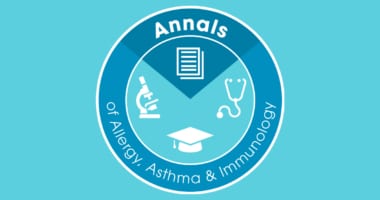 The days are getting longer as we get closer to the spring allergy season. Although our emphasis in this month’s issue of the Annals of Allergy, Asthma and Immunology has been on anaphylaxis, there are other features of interest and importance that should be useful to you.
The days are getting longer as we get closer to the spring allergy season. Although our emphasis in this month’s issue of the Annals of Allergy, Asthma and Immunology has been on anaphylaxis, there are other features of interest and importance that should be useful to you.
One of our valuable features to practicing clinicians is Perspectives. In these evidence-based opinion pieces, the authors advance their ideas and support them with relevant literature citations. There are several in this month’s issue. Anca Mirela Chiriac, MD, PhD, and Pascal Demoly, MD, PhD, from Montpellier, France write about drug-induced anaphylaxis (DIA), which is a well-recognized risk factor for virtually all classes of medications. The incidence and specific risk factors vary widely depending upon the class of drug and reported populations around the world. This perspective addresses recent data reported on DIA and its impact on the understanding of the epidemiology, pathophysiology and management of anaphylaxis. In another Perspectives article, David González-de-Olano, MD, PhD, Almudena Matito, MD, PhD, and Ivan Alvarez-Twose, MD, PhD, from Madrid, Spain discuss the spectrum of mast cell activation syndrome. Their position is that anaphylaxis is part of this spectrum. They go on to defend their position by providing clinical, mechanistic and epidemiological evidence.
The February issue contains other emphases as well. One of them is an International Consensus Document (ICON) on ocular allergy, a common immunological inflammatory process of the anterior surface of the eye. This ICON provides an overview of ocular allergy and identifies unmet needs associated with the diagnosis and management of the spectrum, including seasonal/intermittent, perennial/persistent, vernal and atopic keratoconjunctivitis. It advances ideas about different phenotypes and approaches to therapy that can be derived from specific data collected from history, physical exam and focused laboratory tests.
And finally, our February issue contains the annual “best of” written by the Annals editors, who provide our thoughts as to the most impactful articles published in 2019. The manuscripts we accept and publish are the best of those submitted and we, as editors, endorse all of them. However, those listed in this article represent the best of the best. We recommend that you read (or re-read) these impactful articles and keep in mind the comments that come from our “best of” article. We believe it will be well worth your time.
I wish each of you a busy, successful spring allergy season as we all provide the outstanding patient care that characterizes our specialty. Should you, as you read the pages of our journal, decide you would like to share some thoughts about a specific article, letter, perspective or other feature, feel free to email your thoughts directly to our editorial office. Commentary should be no longer than 500 words and must cite the article about which you are commenting. We will publish it in a future issue of the Annals.
Gailen D. Marshall, Jr., MD PhD
Editor-in-chief

